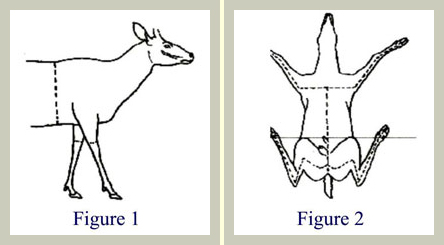Resources
When you harvest a trophy, do you know how to care for it?
I hope in the next page or two I will enlighten you on trophy care for your next animal. What I will explain to you is my preferred method. It is always best to visit with the taxidermist of your choice and discuss with him how he would like to receive your trophy. It is best to choose your taxidermist prior to going afield. That way when you complete your hunt you can get your trophy to him quickly and in the fashion he would like.
Caping is the process of skinning out your trophy. The skinning around the delicate parts, such as the eyes, nose, lips, and ears is best left up to the taxidermist. However there are times when you must do these yourself. That is when it is not possible to cool the hide adequately, in hot weather or on remote hunts. Most of the archery hunts happen in warm weather, where the spoilage of the meat and cape become a factor.
Many trophies are ruined in the first few hours after death. As soon as the animal dies bacteria begins to attack the carcass. Heat and moisture is the ideal environment for the bacteria that causes slippage. Always remember that the cape or skin will also spoil just as the meat will.
Skinning Life-Size Big Game
There are two major methods for skinning for large life-size mounts. These methods are the Dorsal Method and the Flat Incision.
Flat Incision
The flat incision is used for rugs, and a variety of life-size poses. Make the cuts as in figure 2 cutting through the ankles leaving the feet inside the hide. Peel the hide off the carcass and detaching the head as in the shoulder mount instructions. Cool the hide in shade until heat has left it (Don’t let it dry out!) Then place on ice or freeze. Once again get to your taxidermist as soon as possible.
Dorsal Method
The Dorsal Method of skinning involves a long cut from the base of the tail to the neck. The carcass is pulled out through this one incision. Using the same information as stated above. Leaving the head, and feet inside the skin. Freeze immediately. Use this method only if you taxidermist agrees. This method works good on long haired animals.
Caping for a Shoulder Mount
When field dressing, do not cut past the breast bone! Make a circular cut all the way around the animal’s mid section half way between the front legs and the rear legs. Make a second cut all the way around each knee. (or use a saw and cut off each leg just above the knee.) Figure 1. Hang the animal by it’s rear legs after the circular cuts have been made. Skin down to the base of the neck and cut through the neck at the base of the skull. The skin will come off the legs similar to a sock as you skin toward the head. On most trophies it is not necessary to make a cut up the back of the neck. Only make this cut on elk.
At this point you can freeze the head and skin or put it in a cooler with some ice. Do not seal tight in plastic. Let it breath. It is important to get it to your taxidermist as soon as possible. NEVER put any salt on any part of the skin unless you have skinned it completely off the head and have turned the eyes, nose, ears, and lips inside-out. Turning the eyes, ears, lips, nose is best left to the taxidermist. If you are on a back county hunt and need to do this please get instruction from your taxidermist.

Do’s and Don’ts
- Always use a sharp Knife, and have a method of keeping it sharp.
- Always cut in a straight line, if you fade to one side, gradually head back to where you want to go. Do not make radical direction changes.
- Always cool the hides and freeze as soon as possible.
- Always clean blood off hair.
- Always leave enough hide.
- Never salt!
- Never drag animal.
- Never use PLASTIC BAGS.
- Never Air-Dry hides.
